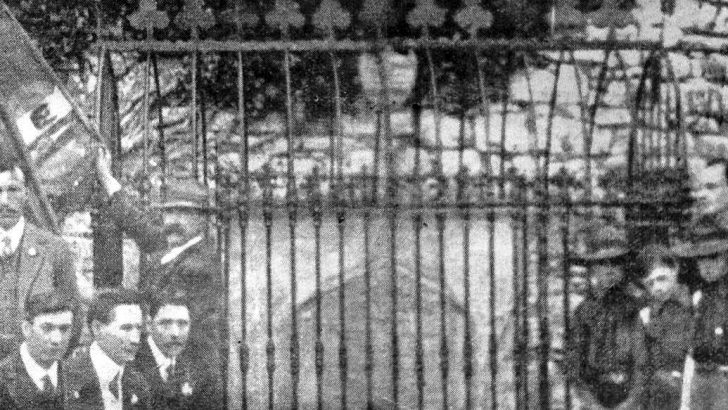Bodenstown Revisited: The grave of Theobald Wolfe Tone, its monuments and its pilgrimages
by C.J. Woods
(Four Courts Press, €50.00)
Bodenstown is near Sallins in Co. Kildare. Here in the local cemetery Theobald Wolfe Tone was buried in 1798, after cutting his throat on being refused a soldier’s execution. Ever since it has been the spiritual home of Irish Republicans and their creed.
This account of the place and its role in the centuries since is a remarkable piece of work. In his comprehensive and insightful study of the annual commemorations at Bodenstown, historian C. J. Woods, who retired in 2006 from the Royal Irish Academy, where he worked on the New History of Ireland and the Dictionary of Irish Biography, provides an unprecedented treasure trove of information and wise analysis on all aspects of the republican movement.
Thomas Davis, the Young Irelander, discovered the grave in 1843 and lionised the iconic republican. This initiated a tradition among nationalists of romanticising about the life and exploits of Wolfe Tone and thereby a legend was born.
Shrine
Wolfe Tone’s grave became a shrine to which republicans of all eras and of all hues felt constrained to make an annual pilgrimage. These pilgrimages are the subject of a painting in 1929 by Jack B. Yeats, himself a man of radical sentiment.
The author lists some of those who made significant appearances or who delivered ‘orations’ at Bodenstown.
It includes John Devoy, John Daly, Fred Allan, James Connolly, John MacBride, Tom Clarke, Patrick Pearse, Seán O’Casey, Constance Markiewicz, Mary MacSwiney, W. T. Cosgrave, Eamon de Valera, Brian O’Higgins, Peadar O’Donnell, Séan MacBride, Thomás Mac Giolla, Séamus Costello, Ruarí Ó Brádraigh, Máire Drumm, Gerry Adams and Martin McGuinness. In their contributions the women listed were bellicose and said nothing of particular concern to women in general.
Woods provides a meticulous account of the pilgrimages to Bodenstown from the 1870s onwards. They were organised by a wide variety of principals but mainly by the IRB, the National Graves Association or Sinn Féin in one or other of its manifestations.
Highlight
Following the establishment of the Irish Free State in 1922, the Irish defence forces paid an annual visit to Bodenstown until 1975. From its inception in 1926 the Fianna Fáil Party has organised an annual rally to Bodenstown to honour the memory of Wolfe Tone and highlight its claim to be every bit as republican as Sinn Féin.
The number attending and the mood of the participants in the Sinn Féin pilgrimages reflected IRA militancy and splits in the movement. It was not until recent years that Ulster impacted on the Bodenstown rallies.
On October 31, 1969 the UVF planted a bomb which destroyed the memorials at Wolfe Tone’s grave. On June 22, 1975 the same group planted a bomb near Sallins to derail a train carrying Bodenstown-bound pilgrims and during the operation murdered an uninvolved passer-by.
The author surveys the relationship between Catholic clergy and the demonstrations at Bodenstown. Wolfe Tone was associated with the physical-force tradition in Irish Republicanism, so not surprisingly the Catholic bishops were totally opposed to the presence of priests at gatherings at Bodenstown.
Nonetheless priests did attend. Fr Thomas Burbage accompanied his friend de Valera to the Fianna Fáil rallies, Fr Michael Byrne, parish priests of Kill, which included the location of the Wolfe Tone memorial, attended as did his curate Michael Carter, both of whom made no effort to conceal their staunch support for Irish Republicanism in all its guises.
By and large Irish republicans were Catholics, many of them devout Catholics. Thus, in the 19th and 20th Centuries the recitation of a decade of the Rosary in Irish was a constant at republican commemorations.
In a sign of the times Roy Johnston, a left-wing academic and member of the Dublin Wolfe Tone Society, in June 1966 objected to Catholic prayers at republican commemorations, including those at Bodenstown.
Yet in April 1971 the parish priest and curate of Kill were present, together with a Capuchin friar, a Presbyterian minister and Church of Ireland clergyman, to provide the benediction at the new memorial at Wolfe Tone’s grave.
Differences
Woods highlights the differences between the speeches in earlier times and those in recent years. Apart from a ritualistic nod in the direction of Wolfe Tone, Fianna Fáil and the Sinn Féin parties took the opportunity to set out and promote their policies.
There were also sub-texts, in the case of Fianna Fáil the struggle between Jack Lynch and Charles Haughey for the soul of the party, and the various Sinn Féin factions availed of the opportunity to attack each other.
The book is altogether an epitome of the course of Irish politics.


 Patrick Pearse and Republican Boy Scouts at Bodenstown
Patrick Pearse and Republican Boy Scouts at Bodenstown 